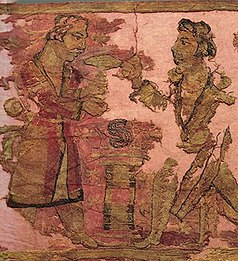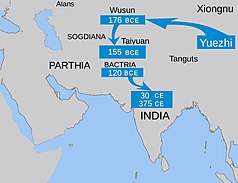یوئهچی
یوئهچی، یوئهجی یا یوئهژی (چینی: 月氏؛ پینیین:Yuèzhī) مردمانی بودند که در آغاز در چراگاههای شرق حوضهٔ تاریم -در سینکیانگ در غرب گانسو در چین کنونی- میزیستند. در برخی منابع کلاسیک تاریخی آنان را با تخاریها یکسان دانستهاند. آنان سپس به فرارود و باختر کوچ نمودند و شاخهای از آنان شاهنشاهی کوشان را پایهریزی نمودند. برخی پژوهشگران بر این باورند که این مردمان از تبار هندواروپایی بوده و برخی دیگر بر این باورند که اینها هزاره تبار هستند یکی از اقوام کهن افغانستان بوده اند .[۱۲][۱۳]اگرچه بعضی از دیگر محققان آنها را با مصنوعات فرهنگهای منقرض شده در حوضه تاریم، مانند مومیاییهای تاریم و متونی که به زبانهای تُخاری نوشته شده مرتبط دانستهاند اما این ارتباط بهطور قطعی ثابت نشده است.[۱۴]
| کل جمعیت | |
|---|---|
| حدود ۱۰۰٬۰۰۰ تا ۲۰۰٬۰۰۰ سوار کماندار، بر پایه Shiji, Chapter 123.[۷] بر اساس Hanshu Chapter 96A: خانوار ۱۰۰٬۰۰۰ , ۴۰۰٬۰۰۰ نفر با ۱۰۰٬۰۰۰ نفر قادر به حمل اسلحه.[۸] | |
| مناطق با جمعیت چشمگیر | |
| چین غربی | (قبل از سده دوم پیش از میلاد)[۷] |
| آسیای میانه | (از سده دوم پیش از میلاد الی سده اول میلادی) |
| شمال هند | (سده اول میلادی الی سده چهارم میلادی) |
| زبانها | |
| زبان باختری[۹] (در باختر، سده یکم میلادی) | |
| دین | |
| بودایی هندو[۱۰] Jainism[۱۱] شمنباوری زرتشتی Manichaeism Kushan deities | |

جستارهای وابسته
ویرایشمنابع
ویرایش- ↑ Francfort, Henri-Paul (1 January 2020). "Sur quelques vestiges et indices nouveaux de l'hellénisme dans les arts entre la Bactriane et le Gandhāra (130 av. J. -C. -100 apr. J. -C. environ)". Journal des Savants (به انگلیسی): 26–27, Fig.8 "Portrait royal diadémé Yuezhi" ("Diademed royal portrait of a Yuezhi").
- ↑ Considered as Yuezhi-Saka or simply Yuezhi in Polos'mak, Natalia V.; Francfort, Henri-Paul; Tsepova, Olga (2015). "Nouvelles découvertes de tentures polychromes brodées du début de notre ère dans les "tumuli" n o 20 et n o 31 de Noin-Ula (République de Mongolie)". Arts Asiatiques. 70: 3–32. doi:10.3406/arasi.2015.1881. ISSN 0004-3958. JSTOR 26358181.
p.3: "These tapestries were apparently manufactured in Bactria or in Gandhara at the time of the Saka-Yuezhi rule, when these countries were connected with the Parthian empire and the "Hellenized East." They represent groups of men, warriors of high status, and kings and/ or princes, performing rituals of drinking, fighting or taking part in a religious ceremony, a procession leading to an altar with a fire burning on it, and two men engaged in a ritual."
- ↑ Nehru, Lolita (14 December 2020). "KHALCHAYAN". Encyclopaedia Iranica Online (به انگلیسی). Brill.
About "Khalchayan", "site of a settlement and palace of the nomad Yuezhi": "Representations of figures with faces closely akin to those of the ruling clan at Khalchayan (PLATE I) have been found in recent times on woollen fragments recovered from a nomad burial site near Lake Baikal in Siberia, Noin Ula, supplementing an earlier discovery at the same site), the pieces dating from the time of Yuezhi/Kushan control of Bactria. Similar faces appeared on woollen fragments found recently in a nomad burial in south-eastern Xinjiang (Sampula), of about the same date, manufactured probably in Bactria, as were probably also the examples from Noin Ula."
- ↑ Yatsenko, Sergey A. (2012). "Yuezhi on Bactrian Embroidery from Textiles Found at Noyon uul, Mongolia" (PDF). The Silk Road. 10.
- ↑ Polosmak, Natalia V. (2012). "History Embroidered in Wool". SCIENCE First Hand (به انگلیسی). 31 (N1).
- ↑ Polosmak, Natalia V. (2010). "We Drank Soma, We Became Immortal…". SCIENCE First Hand (به انگلیسی). 26 (N2).
- ↑ ۷٫۰ ۷٫۱ Watson 1993, p. 234.
- ↑ Hulsewé, A.F.P. and Loewe, M.A.N. China in Central Asia: The Early Stage: 125 B.C. -A.D. 23: An Annotated Translation of Chapters 61 and 96 of the History of the Former Han Dynasty. Leiden. E. J. Birll. 1979. شابک ۹۰−۰۴−۰۵۸۸۴−۲, pp. 119–120.
- ↑ Hansen 2012, p. 72.
- ↑ Bopearachchi 2007, p. 45.
- ↑ Wink, André (1997). Al-Hind, the Making of the Indo-Islamic World: The Slavic Kings and the Islamic conquest, 11th–13th centuries. Oxford University Press. p. 57. ISBN 90-04-10236-1.
- ↑ (Narain 1990، صص. 152–155) "[W]e must identify them [Tocharians] with the Yueh-chih of the Chinese sources... [C]onsensus of scholarly opinion identifies the Yueh-chih with the Tokharians... [T]he Indo-European ethnic origin of the Yuehchih = Tokharians is generally accepted... Yueh-chih = Tokharian people... Yueh-chih = Tokharians..."
- ↑ (Roux 1997، ص. 90) "They are, by almost unanimous opinion, Indo-Europeans, probably the most oriental of those who occupied the steppes."
- ↑ Mallory & Mair 2000, pp. 283–284.
Wikipedia contributors, "Yuezhi," Wikipedia, The Free Encyclopedia, http://en.wiki.x.io/w/index.php?title=Yuezhi&oldid=609932198 (accessed August 31, 2014).

